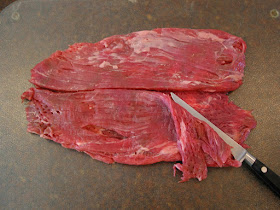Matambre is one of the traditional Argentinean beef
dishes, some say the name comes from the contraction and combination of two
words "Mata" (Kill) and "Hambre" (Hunger), anyway it is
just a particular cut of meat that we can cook in different ways and styles.
The most common recipe is for a stuffed rolled matambre.
El
Matambre es uno de los platos tradicionales de carne en Argentina, algunos dicen
que el nombre proviene de la contracción y combinación de las palabras
"Mata" y "Hambre", de todos modos es simplemente un corte
de carne que podemos cocinar de distintas formas y estilos. La receta más común
es la del matambre relleno arrollado.
 |
| Source: (C) National Live Stock and Meat Board |
The cut is from the bottom area
and attached to the lower section of the ribs, it is slightly different in the
United States where a similar cut is called "Flank Steak". Some
people confuse this cut with the "Skirt Steak" or as they call it in
Mexico "Fajitas". No, "Flank Steak" and "Skirt
Steak" are not the same cut but they are from the same area.
 |
Source: Instituto de Promoción de la
Carne Vacuna Argentina |
El
corte es de la parte inferior que se encuentra adherida a la sección baja del
costillar, es ligeramente diferente en Estados Unidos donde a un corte similar
se lo llama "Flank Steak." Algunas personas confunden este corte con
el "Skirt Steak" que en México son las "Fajitas", estos son
cortes distintos pero se obtienen de la misma área.
There are different ways to
prepare the stuffed rolled flank steak, I'll share with you one of the ways we do
it at home.
Existen
diferentes formas de preparar el flank steak relleno y arrollado, voy a
compartir con ustedes una de las formas en la que lo preparamos en casa.
Cut the flank steak in butterfly style.
Cortar el flank steak en estilo mariposa.
Tenderize a little bit with an appropriate mallet.
Tiernizar ligeramente con un martillo apropiado.
Spread fresh chopped garlic and italian parsley, and season with a little bit of salt, black and red pepper.
Untar con ajo y perejil frescos picados, sazonar con un poco de sal, pimienta negra y roja.
Make a layer with some bacon strips and grated cheeses. Some people use gelatin powder instead of cheese, I prefer cheese.
Hacer una capa con unas tiras de tocino y queso rallado. Algunas personas utilizan polvo de gelatina en lugar de queso, yo prefiero el queso.
Now make a layer with plenty of fresh spinach, carrots and hard boiled eggs cut in half. Add more seasoning.
Ahora hacer una capa con un bastantes hojas de espinacas frescas, zanahorias y huevos duros cortados por la mitad. Agregar más condimentos a gusto.
Roll the matambre and close (not too tight) with cooking twine.
Enrolle el matambre y cerrar (no muy fuerte) con hilo para cocinar.
When finished it has to look more or less like this picture. I normally let it rest for few hours or overnight in the refrigerator wrapped with plastic foil.
Cuando haya terminado se tiene que ver más o menos como esta imagen. Yo normalmente lo dejo reposar en el refrigerador durante unas horas o toda la noche envuelto en plástico.
To cook first seal on hot iron pan with olive oil, onions and peppers, from there take to the oven (400 °F) to finish cooking on a recipient filled with beer until internal temperature reaches over 165
°F , keep it moist, add more beer
if needed.
Para cocinar, primerero se sella en una sartén de hierro caliente con aceite de oliva, cebollas y pimientos, luego se pasa a un recipiente con cerveza para terminar de cocinar en el horno (200 °C) hasta que la temperatura interior llegue a más de 74
°C . Evitar que se seque agregando más cerveza si es necesario.
This is a very traditional dish in Argentina for the holidays and we often serve it as a cold meat with a potatoes and veggies salad that we call "Ensalada Rusa", you can also cut it in thin slices and use for sandwiches or just finish to cook it on a grill.
Este es un plato muy tradicional en la Argentina para las fiestas, que a menudo servimos como plato frío acompañado de una ensalada de papas con verduras que llamamos "Ensalada Rusa", también se puede rebanar en rodajas finas y usar como fiambre para sandwiches, o terminar de cocinar a la parrilla.
Buen Provecho
Jorge
Pin It





















































